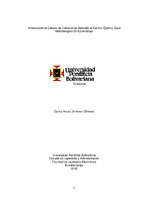| dc.contributor.advisor | Barrios Urueña, Edgar | |
| dc.contributor.author | Jiménez Oliveros, Carlos Arturo | |
| dc.coverage.spatial | Seccional Bucaramanga. Universidad Pontificia Bolivariana. Escuela de Ingenierías. Facultad de Ingeniería Electrónica | spa |
| dc.coverage.temporal | 2012 | |
| dc.date.accessioned | 2015-01-27T16:04:29Z | |
| dc.date.available | 2015-01-27T16:04:29Z | |
| dc.date.created | 2013-03-07 | |
| dc.date.issued | 2015-01-27 | |
| dc.identifier.uri | http://hdl.handle.net/20.500.11912/2007 | |
| dc.description | 102p.: (pdf); il; gráficas, anexos | spa |
| dc.description.abstract | El Cálculo de variaciones es un método matemático que permite buscar máximos y mínimos de funcionales continuos definidos sobre un funcional. Tiene múltiples aplicaciones, entre ellas está el uso en control óptimo para hallar el controlador de un sistema de control que maximice o minimice una condición especificada. En este Proyecto se desarrolla se estudia la metodología del Cálculo de Variaciones, se desarrollan ejercicios propuestos en algunos textos de la literatura técnica y se realiza una guía para facilitar la comprensión de los principios del Cálculo de Variaciones y su aplicación al Control Optimo. Se estudia el Cálculo de Variaciones aplicado al Control Óptimo, específicamente los temas “problema de punto final fijo” y “problema de punto final móvil”. Se estudió la herramienta matemática Maple y se utilizó en el desarrollo de los ejercicios, para resolver ecuaciones matemáticas complejas; el uso de MAPLE facilitó la obtención de la expresión de Euler–Lagrange y la solución de ecuaciones diferenciales, pasos importantes para encontrar el extremal. Una vez culminado el estudio de la teoría se difundió los resultados obtenidos presentando a la comunidad UPB-Bucaramanga en un seminario introductorio al Cálculo de Variaciones aplicado al Control Optimo. | spa |
| dc.description.abstract | The calculus of variatins is a mathematical problema which consists is findig the maximun and mínimum of defined continuos functions. On some functional space, is an alternative method to find a controller in the conventional manner as is the bode diagram, root locus, or other usual methods of classical control.
According to the above guidance was developed to make the foundation for understanding the calculus of variations applied to optimal control which presents the theory and exercises in a didactic learning mode because the information found in books is very difficult to understand, the other difficulty is that these books are not easy to find.
This Project studied the calculus of variations applied to optimal control, specifically the topics "problema of fixed final point" and problems in which the final point is mobile.
Maple tool was very useful in the solution of the exercises, to solve very large mathematical ecuations. And with the software the solution of differential ecuations was facilitated, and finding the Euler-LaGrange expression, important steps to find the extremal.
Once completed the study of the theory I released the results to the community of UPB Bucaramanga in an introductory seminar to the calculus of variations applied to the optimal control. | |
| dc.language.iso | es | |
| dc.publisher | Universidad Pontificia Bolivariana | spa |
| dc.rights | Attribution-NonCommercial-NoDerivatives 4.0 International | * |
| dc.rights.uri | http://creativecommons.org/licenses/by-nc-nd/4.0/ | * |
| dc.subject | Tesis y disertaciones académicas | spa |
| dc.subject | Cálculo de variaciones | spa |
| dc.subject | Reguladores secuenciales programables | spa |
| dc.title | Introducción al cálculo de variaciones aplicado al control óptimo: Guía metodologíca de aprendizaje | spa |
| dc.type | bacherlorThesis | spa |
| dc.rights.accessRights | openAccess | spa |
| dc.type.hasVersion | publishedVersion | spa |
| dc.identifier.instname | instname:Universidad Pontificia Bolivariana | spa |
| dc.identifier.reponame | reponame:Repositorio Institucional de la Universidad Pontificia Bolivariana | spa |
| dc.identifier.repourl | repourl:https://repository.unab.edu.co/ | |


